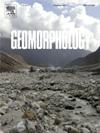How does hydropower station construction reshape the geomorphology of downstream mid-channel bars?
IF 3.1
2区 地球科学
Q2 GEOGRAPHY, PHYSICAL
引用次数: 0
Abstract
Fluvial geomorphological changes have profound implications for the health and functionality of river ecosystems. The influence of hydropower dams on downstream geomorphology and the environment demands immediate investigation. However, current research methods are intricate, posing substantial challenges. This study focuses on the mid-channel bar (MCB), a crucial fluvial landform, to explore how hydropower development affects downstream fluvial geomorphology. Using global surface water datasets, the study analyzed nearly 20 years of MCB data from downstream of 10 hydropower stations along the Yangtze, Yellow, and Pearl Rivers. The results indicated that: 1) From 2000 to 2021, the total area of MCBs downstream of hydropower stations in major Chinese rivers experienced a remarkable decline. Approximately 80 % of the reduction (4.83 km2) occurred in the Yangtze River. The rate of decrease varied among river basins. The Yangtze River experienced the steepest decline at a rate of −0.23 km2/yr, followed by the Yellow River (−0.05 km2/yr) and the Pearl River (−0.01 km2/yr). 2) The impact of hydropower damming on changes in MCB area differed before and after river closure. In most cases, the rate of decrease accelerated significantly after river closure. 3) For individual MCBs, around two-thirds showed a downward trend in area, with the rate of decline accelerating after river closure. The reduction in MCB area is primarily attributed to three factors: decreased downstream sediment supply due to sediment trapping in reservoirs, changes in flow dynamics caused by dam regulation, and internal factors such as MCB type and evolution trajectory. This study provides a novel perspective on understanding the ecological impacts of hydropower and offers scientific support for fluvial geomorphology management and ecological conservation.
求助全文
约1分钟内获得全文
求助全文
来源期刊

Geomorphology
地学-地球科学综合
CiteScore
8.00
自引率
10.30%
发文量
309
审稿时长
3.4 months
期刊介绍:
Our journal''s scope includes geomorphic themes of: tectonics and regional structure; glacial processes and landforms; fluvial sequences, Quaternary environmental change and dating; fluvial processes and landforms; mass movement, slopes and periglacial processes; hillslopes and soil erosion; weathering, karst and soils; aeolian processes and landforms, coastal dunes and arid environments; coastal and marine processes, estuaries and lakes; modelling, theoretical and quantitative geomorphology; DEM, GIS and remote sensing methods and applications; hazards, applied and planetary geomorphology; and volcanics.
 求助内容:
求助内容: 应助结果提醒方式:
应助结果提醒方式:


